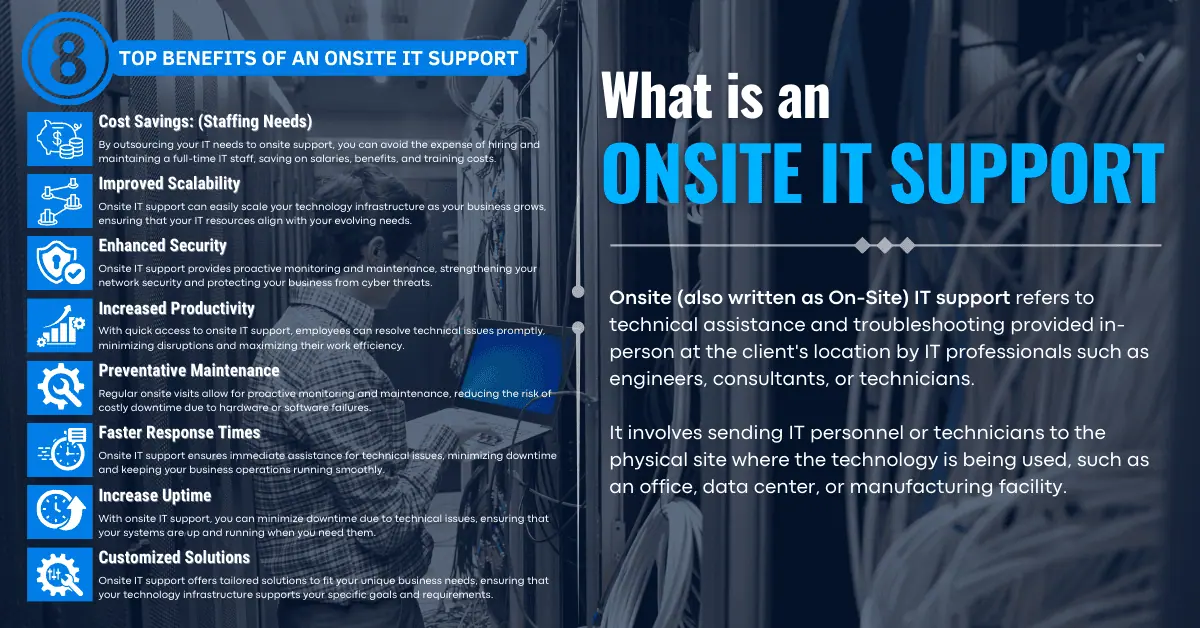What is Onsite IT Support?
Onsite IT support, also called field IT support, is technical assistance provided by IT professionals who visit clients to fix issues at their physical locations. This service involves troubleshooting hardware and software problems, setting up network systems, and delivering customized IT solutions. The main difference between onsite and remote IT support is that an onsite technician can physically handle the tools and devices, making hands-on troubleshooting more effective, especially for complex or urgent issues.
For businesses experiencing critical IT emergencies, onsite IT support becomes vital when experiencing hardware failures, network outages, or critical software updates that cannot be addressed remotely. For example,if a small or medium-sized business encounters a server crash or network infrastructure malfunction, an onsite technician can diagnose and fix the issue quickly, restoring normal business operations with minimal disruption. They also offer real-time security assessments to strengthen a business’s data protection practices.
Onsite IT support has other advantages, like quicker resolution times for hardware issues, better protection from direct system interventions, and tailored IT solutions to the business’s needs. This proactive approach to system management means systems are running smoothly and less likely to have outages, enabling companies to concentrate on their core operations.
Table of Contents
What is the Role of Onsite IT Support?
Onsite IT support is essential for maintaining business IT systems, offering critical services such as hardware repair, software management, network troubleshooting, technical assistance, security assessments, IT asset management, and data backup and recovery. These services ensure smooth operations, enhanced security, and minimal downtime through direct, hands-on system management.
Hardware Support
Hardware support involves diagnosing, finding, and resolving issues for physical devices, including computers, servers, printers, and peripherals. They replace malfunctioning parts, order replacement equipment, and verify that all hardware runs at peak efficiency. This service reduces business downtime by dealing with all kinds of hardware problems, thus ensuring smooth operation on a day-to-day basis without disruptions due to equipment failures.
Software Support
Software support also involves installing, configuring, updating, and troubleshooting applications to ensure smooth operations. Onsite technicians deal with physical support, OS issues, office suites, and complex business applications. It also includes supplying businesses with custom software solutions based on business needs. All created components will always perfectly meet any company’s operational needs by increasing daily productivity.
Network Support
Network support maintains connectivity and data flow throughout the firm. This includes managing and resolving issues with routers, switches, firewalls, and wireless access points to keep the network secure, efficient, and available with minimal downtime. Optimal network performance enables business operations to continue and ensures secure communications.
Technical Support
Technical Support is the first line of defense when hardware, software, or network malfunctions occur. Onsite technicians provide hands-on help to solve technology issues quickly, ensuring that employees remain productive without prolonged interruptions.
Security Assessment
Regular security assessments quickly provide insights into an organization’s IT environment’s security vulnerabilities. Onsite IT teams perform vulnerability scans and penetration testing to strengthen the security posture, improve security controls, and ensure robust compliance.
IT Asset Management
IT Asset Management (IAM) involves tracking and managing a company’s technology assets, including hardware resources, software licenses, and network equipment. Onsite IT support ensures assets are accounted for, maintained, and replaced when necessary to utilize technology optimally and manage costs efficiently.
Data Backup and Recovery
Data backup and recovery services ensure that critical business data is backed up periodically and can be recovered in case of accidental deletion, failure, or corruption. Backup solutions and recovery operations are implemented and monitored to protect business continuity and avoid potential disaster scenarios.
When Should You Opt For Onsite IT Support?
Businesses should opt for Onsite IT Support when they require immediate, hands-on assistance with complex or sensitive IT issues. This includes hardware installations, network configurations, handling critical system failures, and security audits to ensure compliance with regulations. Onsite support is ideal for companies dealing with sensitive data or those with geographically dispersed locations where personalized service and quick response times are crucial.
Hands-On Assistance Needed
Onsite support is crucial for troubleshooting hardware problems, installing equipment, and reducing downtime. Technicians offer in-person services to diagnose and repair issues related to IT physical presence, such as hardware repairs, software configuration, or resolving issues that require on-site technical IT service delivery. Businesses that rely heavily on hardware for daily functionality would benefit from this service.
Complex IT Environments
An on-site visit provides an in-depth system assessment for large networks or enterprise-environment installations to ensure a definitive diagnosis and resolution. IT support technicians can optimize infrastructure, upgrade advancements, and troubleshoot issues that may be neglected by remote support. They also help customize solutions for more sophisticated systems to increase productivity and safety measures.
Critical Systems and Services
Onsite support is a must for critical systems like servers, databases, etc. This means you will get an in-person intervention for immediate resolution, which lowers downtime and allows the business to continue as soon as possible. This approach is essential in industries like finance or healthcare, where uninterrupted services must be available continuously. It can result in financial loss, operational disruption, and reputational damage if not.
Sensitive Data Handling
Organizations dealing with sensitive data, such as healthcare and financial institutes, need on-site support’s strict data protection protocols that adhere to GDPR, HIPAA, and other relevant regulations.The physical presence of an on-field IT support technician allows for monitoring potential breaches and addressing security vulnerabilities. This ensures rapid responses if such threats present themselves, guaranteeing regulation compliance and data integrity.
Geographically Dispersed Locations
Businesses increasingly spread worldwide and require onsite IT support providers that maintain flexible call-routing arrangements. Onsite IT support benefits businesses with multiple or remote locations by providing site-specific solutions. Technicians respond promptly to hardware and network issues, ensuring consistent IT service across all locations, minimizing downtime, and maximizing operational efficiency.
How Businesses Can Benefit from Onsite IT Support?
For any business, onsite IT support should be considered a fundamental service to enhance operational effectiveness and security while minimizing technical downtime. On-site IT personnel at your location help resolve problems promptly, deliver individual service, and ensure system availability. Having skilled tech support physically available onsite at your office can be handy when you require help with troubleshooting, security assessments, or system updates.
Here are the 8 Top Benefits of Onsite IT Support
- Cost Savings on Staffing Needs
- Improved Scalability
- Enhanced Security
- Increased productivity
- Preventative Maintenance
- Faster response times
- Increase Uptime
- Customized Solutions
1. Cost Savings on Staffing Needs
Onsite IT support services minimize the necessity for full-time in-house IT staff. Businesses can simply outsource their IT requirements and pay for only what they need, eliminating unnecessary expenses related to hiring, training, and retaining staff. Particularly useful for small businesses, this offers ways to manage costs while receiving expert help.
2. Improved Scalability
A company’s IT infrastructure expands accordingly with its growth. Hardware and software upgrades are immediately provided with onsite IT support, allowing them to scale without interruption. This flexibility lets businesses quickly expand IT resources without hiring new staff, enabling growth without disrupting operations.
3. Enhanced Security
All small or large companies are concerned about security, especially those handling confidential data. A robust onsite IT support team conducts periodic security checks, detecting vulnerabilities remote setups may overlook. IT professionals take proactive security measures to ensure compliance and protection from cyber threats, making onsite support service a vital part of cybersecurity strategy.
4. Increased Productivity
Technical issues that cause downtime can harm employee productivity. In-person support offers faster resolution of IT issues, keeping systems up and running. Handling problems immediately helps businesses maintain productivity, allowing employees to focus on their core tasks without interruptions.
5. Preventive Maintenance
Routine maintenance is necessary to prevent significant problems before they escalate. Onsite IT support helps keep systems up-to-date and identifies early warning signs of potential issues, ensuring minimal downtime. A proactive approach reduces the risk of system breakdowns, saving businesses significant repair costs and lost productivity.
6. Faster Response Time
IT professionals present on-site can respond quickly to technical issues. When a device fails, or a major issue breaks out, onsite personnel can promptly assess and resolve the issue, ensuring systems are operational again quickly. This immediate support is critical for time-sensitive tasks that must be completed before the next business day.
7. Increased Uptime
For businesses that require constant system uptime, onsite IT support ensures technical issues are diagnosed and resolved promptly. Routine system checks and fast responses help businesses to maintain uptime, availability, and operational efficiency.
8. Customized Solutions
Every business has unique IT needs. Onsite IT professionals analyze the infrastructure from scratch, offering tailored solutions that fit a business’s unique operational needs. This hands-on, customized approach guarantees that IT systems are fully suited to business demands, increasing performance and productivity.
Challenges of Onsite IT Support
Despite various advantages, onsite IT support presents challenges, such as delayed response times, geographic limitations, increased costs, skill shortages, and workplace safety concerns. Careful and strategic planning and efficient resource management are vital in overcoming these challenges.
Response Time
Various contributing factors, such as geography, traffic, technician availability, and scheduling conflicts, can slow access and delay response time to appropriate on-site IT support. Planning and logistical preparation, such as route optimization and IT support technician availability, are vital to preventing delays and ensuring timely service delivery to meet customer expectations.
Geographic Coverage
Geographic considerations can be problematic for onsite IT support consultants, especially in rural or dispersed locations. Travel costs and longer response times increase operational burdens. Providers address this by deploying regional teams and forming local partnerships to ensure efficient, timely support.
Cost and Resources
Onsite IT support costs are substantial, including travel, labor, and specialized equipment. Balancing quality and cost-effectiveness requires strategic resource management. Remote diagnostics and reduced visit frequency can help optimize costs without compromising service quality.
Skillset Availability
For specialized tasks, it can be challenging to find onsite technicians with the right skill set and expertise. Managed service providers must maintain consistent technical proficiency through training, certifications, and strategic technician allocation to ensure clients receive optimal support.
Workplace Safety
Ensuring workplace safety and addressing potential hazards are critical for on-site IT support. Technicians must be trained in safety protocols, equipped with protective gear, and follow established guidelines to protect themselves and clients during on-site visits.
What Makes up the Right Onsite IT Support Provider?
Key attributes like expertise, service guarantees, and responsiveness are essential aspects that make an on-site IT support provider a good choice for businesses. The best provider offers tailored, scalable solutions while ensuring security, compliance, and excellent communication within your budget.
- Experience and Expertise:
An IT support provider with years of experience in the industry can better understand your business needs. Providers with a track record in your industry will offer tailored guidance and solutions that fit your operations.
- Service Level Agreements (SLAs):
SLAs clarify service delivery conditions like response times, service scope, and performance guarantees. By outlining service levels and compliance rules, a well-defined SLA helps manage expectations for both clients and providers.
- Availability and Response Time:
Providers should offer 24/7 availability with quick response times to minimize system downtime. With constant support, problems are addressed as soon as they arise, ensuring business operations are maintained for a short time.
- Customized Solutions:
Tailored IT support ensures that the provider fits into your specific business concerns. Customized strategies that align with your industry, infrastructure, and objectives guarantee optimal performance and relevance for your business.
- References and Reputation:
Client testimonials and reviews are essential for verifying a provider’s success. High customer satisfaction and industry accreditations reflect a provider’s reliability and ability to consistently deliver quality IT support.
- Security and Compliance:
Providers must adhere to regulatory requirements and maintain strong security measures. This protects sensitive data and ensures compliance with industry-specific laws, fostering client trust and avoiding legal risks.
- Scalability and Flexibility:
Scalable IT support that grows with your business is crucial. Flexible solutions can be easily adjusted without new contracts, allowing seamless service adaptation as your business evolves or faces unexpected challenges.
- Communication and Collaboration:
Effective communication channels between your business and the provider are essential. Providers who offer multiple options (phone, email, chat) and regular updates ensure smooth collaboration and effective problem resolution.
- Value-added Services:
Value-added services, such as additional training, proactive system monitoring, or specialized consulting, enhance the overall support experience. These extras help businesses boost performance and maximize their return on investment.
- Cost and Budget:
IT support must be affordable while maintaining quality. A transparent SLA with clear pricing policies, including any hidden fees, helps businesses manage IT expenses and avoid budget overruns.
Onsite IT Support vs. Remote IT Support
Onsite IT Support offers on-site assistance at the client’s location, helping tackle hardware issues while providing personalized service, whereas Remote IT Support provides faster and comparatively cheaper solutions, mainly software-related, entirely through the internet.
Onsite support excels at handling complex system configurations, minimizing downtime through hands-on troubleshooting, and offering added security through physically monitoring sensitive systems. This type of support is essential for businesses needing immediate, hands-on consultancy services to resolve intricate hardware or network problems that cannot be handled remotely.
Meanwhile, remote IT support operates almost around the clock, offering faster response time and lower costs due to the lack of travel and 24/7 service availability. Its scalability feature makes it ideal for businesses needing flexible and evolving solutions without the higher operational costs associated with onsite visits. However, when it comes to hardware or critical network issues requiring physical intervention, onsite IT support remains the clear winner, providing in-person assistance for immediate resolution.


